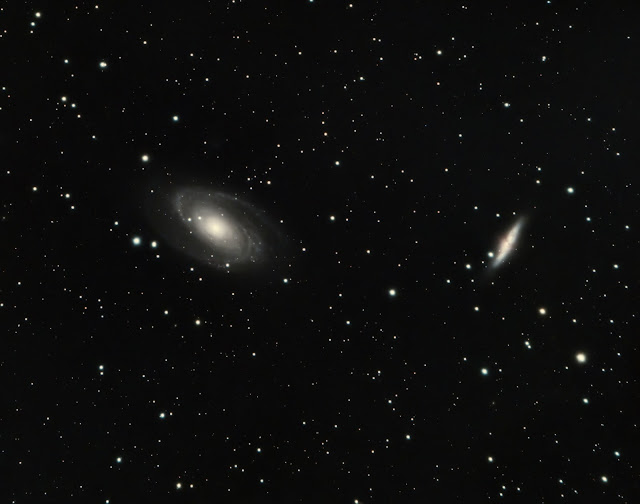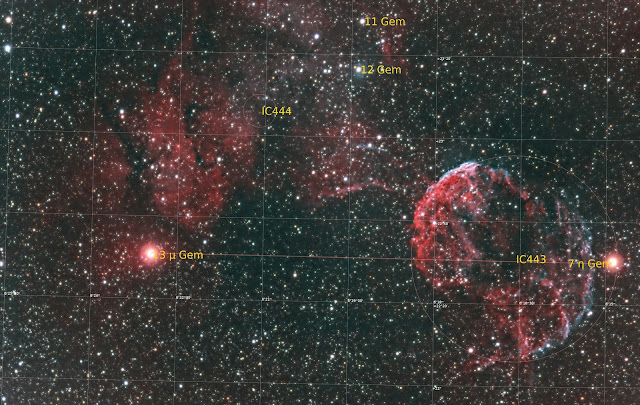Starting up the Bubble Nebula with M52 (RGB)
Why this target?
I was going to head to some more obscure objects but I wanted to capture the Nova in Casseiopia, V1405 Cassiopeiae. It really is amazingly bright compared to last year.
About the Targets
https://apod.nasa.gov/apod/ap110914.html
Embedded in a complex of interstellar dust and gas and blown by the winds from a single, massive O-type star, the Bubble Nebula, also known as NGC 7635, is a mere 10 light-years wide. On the other hand, M52 is a rich open cluster of around a thousand stars. The cluster is about 25 light-years across. Seen toward the northern boundary of Cassiopeia, distance estimates for the Bubble Nebula and associated cloud complex are around 11,000 light-years, while star cluster M52 lies nearly 5,000 light-years away. The wide telescopic field of view spans about 1.5 degrees on the sky or three times the apparent size of the Full Moon.
CAPTURE INFO
Bandwidths:
R, G, B, L
Date Captured:
June 6 & June 10, 2021, Batavia, IL (Bortle 7/8)
GUIDING NOTES:
Good, averaging ~0.7 RMS
IMAGE CALIBRATION (PixInsight)
Weighted Batch Preprocessing
- Lights, Darks, Flat Darks, Bias
- Cosmetic Correction
- Drizzle Generation
- Stats
- R (20) 60 second subs
- G (20) 60 second subs
- B (20) 60 second subs
- Drizzle Integration @ 2x
NON LINEAR PROCESSING (PixInsight)
1. Dynamic Crop
2. Automatic Background Extraction
3. Dynamic Background Extraction
4. Linear Noise Reduction to each channel using MultiscaleLinearTransform
5. Another Linear Noise Reduction using MultiscaleLinearTransform
7. Channels were combined with ChannelCombination
LINEAR PROCESSING (PixInsight)
1. Easy Soft Stretch script
2. SCNR on the G channel
3. Starnet++ to remove the stars and create a image of the stars
4. (Starless Image) Used HistogramTransformation to reduce the background skyglow/light pollution.
5. (Starless Image) TGV Denoise to remove more noise
6. (Starless Image) Ran HDRMultiscaleLinearTransform to smooth background
7. (Starless Image) Ran a slight "S" curve using CurvesTransformation
8. (Starless Image) Ran MultiscaleLinearTransform to sharpen
9. (Starless Image) Ran LocalHistogramEqualization 2 times 25/75 Kernel Radius for Contrast
10. (Stars Image) Decreased star brightness by 10%
11. (Stars Image) Increased saturation of the stars using ColorSaturation
12. Added stars to the background using PixelMath
13. Made image ready for the web using ICCProfileTransformation
EQUIPMENT
Optics: SGO 6" f/4 Imaging Newtonian @ 610mm FL
Baader 2" Coma Corrector
Camera: ZWO 294mm Pro (mono)
Filter Wheel: ZWO 8 position, .36" filters
Filters:
- R (Baader Planetarium LRGB 36 mm Round CCD Filter )
- G (Baader Planetarium LRGB 36 mm Round CCD Filter )
- B (Baader Planetarium LRGB 36 mm Round CCD Filter )
Mount:
- Losmandy GM811
- RAEXT EXTENSION DOVETAIL
- Losmandy 12" Tripod Extension
- Losmandy SADDLE PLATE FOR G-11 MOUNT
- Losmandy 16" UNIVERSAL DOVETAIL PLATE
- Losmandy LW Tripod
- Alt-AZ/Elevation Tensioning bolts and washers (Michael Herman's)
Guiding:
- ZWO 120mm mini (red filter)
- Agena 60mm f/4 (240mm FL) Guide Scope with Helical Focuser
- PHD2 Software (2.6.9 Dev 5)
- Multistar option
- RA algorithm: Predictive PEC
- Dec algorithm: Resist Switch
- Used previous calibration
- Dither: Small, every 3 frames
Acquisition:
- Mini PC Beelink T4 @ scope
- MS Windows Remote Desktop to mini PC
- Sequence Generator Pro 3.2.660



































PSF Signal Weight, Elongation, FWHM, # of Stars"